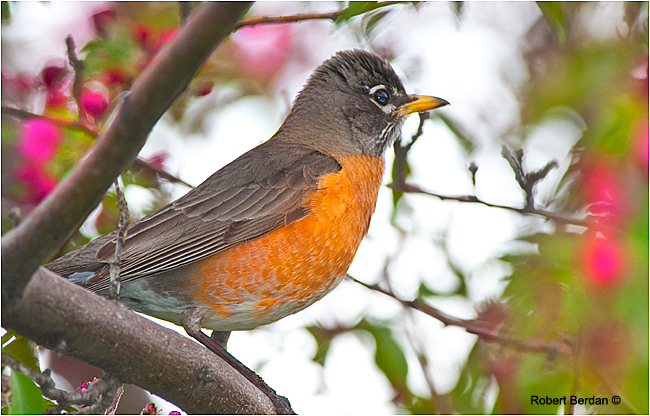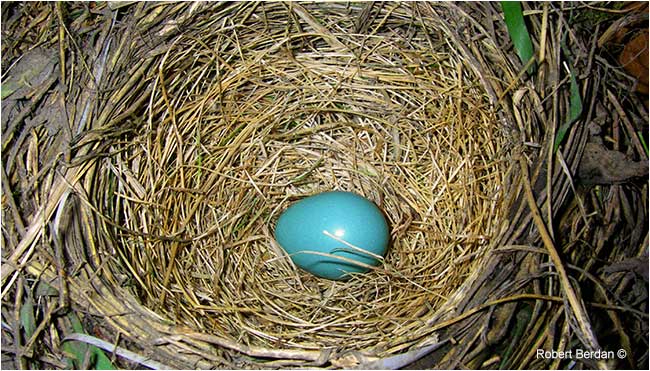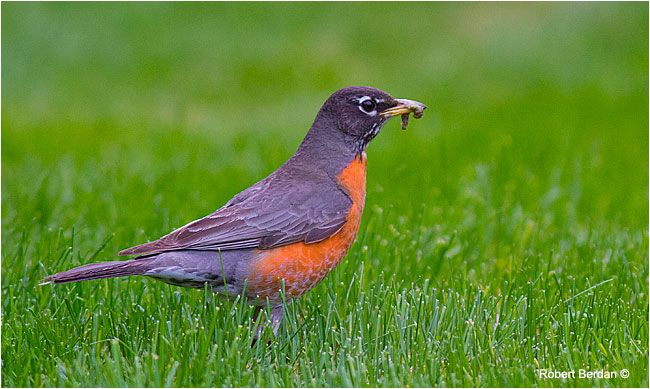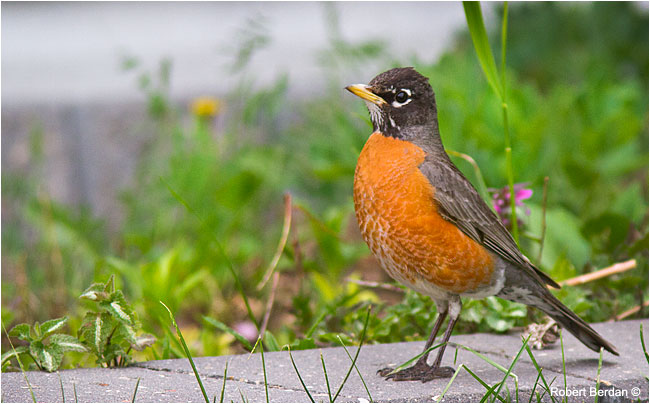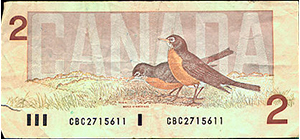
Photographing the Common Robin - A Symbol of Spring
By Dr. Robert Berdan
June 4, 2012
(Updated June 16, 2012)

In Canada, the American Robin (Turdus migratorius) is one of the first birds to arrive in spring. 300 mm F4.
Robins are so common in North America that we barely pay much attention to them, yet they have a beautiful song and are easy to photograph. Most of us take notice when they first arrive in spring as they signal winter is coming to an end. The robin population is estimated to be around 320 million in North America and they are considered an animal of least concern. They are one of the few birds that have adapted successfully to urbanization and appear to have a stable population size, but just because they are common, doesn't mean we shouldn't appreciate these cheery birds. In this article I share some of my favorite pictures of robins including some photographs of eggs and young at the nest. These photographs demonstrate you don't have to travel far to get some interesting nature photographs.
Robin in my backyard. Fill Flash set to -1 EV. Nikon 300 mm + 1.5X teleconverter, F4.8.
Robin in my backyard in a cheery-apple tree. Fill flash set to -1 EV. 300 mm + 1.5X teleconverter, F4.8.
I love to watch and photograph birds in my backyard and this past May I had a pair of robins take up residence in my garage. I usually leave the back door of my garage open which allowed a pair of robins to set up their nest inside. The nest was situated inside the door under the garage roof about eight feet above the ground. Once I spotted the nest, I made certain the door stayed open for duration of their residency. Being concerned for their welfare, I attempted to minimize my disturbance of the nest. To photograph pictures of the eggs and young I used a compact Pentax Optio camera with a remote control and tried to limit the time near the nest to a few minutes or less a day.
Garage in my backyard - Robins made a nest inside the back door under the roof about 8 feet above the ground.
Photographing birds at their nests can make the nests susceptible to predation or abandonment. One should never cut branches to reveal the nest more clearly or do anything that might attract the attention of predators. Since a pair of robins took residence in my garage, which I had to enter daily to access my vehicle, I decided to document their development. I also photographed the mother robin on the nest using a telephoto lens by hiding behind my jeep in the garage. In the early evenings I would sit outside and just watch the adult robins hunt for food and return with morsels of food for their young. Other birds also patrolled my backyard, notably Grackles (Quiscalus quiscula) and Magpies (Pica pica). I also have cedar waxwings (Bombycilla cedrorum) visit my mountain ash tree to eat the dried fruit. I observed Grackles hunt for earthworms under the hedges in my yard, and Magpies systematically check out the nearby pine trees presumably looking for bird nests to raid.
First egg appeared May 19th, 2012
Second egg appeared on May 20th, 2012
Third egg appeared on May 21, 2012
Fourth egg appeared on May 22 - no additional eggs were found on subsequent days. The first chick appeared on June 2 - 11 days after the first egg was laid, by June 3rd there was three chicks and by 14 days all eggs had hatched.
Robins usually nest 5-15 feet above the ground in a dense bush or between two tree branches. They are also apparently not shy about nesting near human habitat, Their nest is constructed by the female and consists of an outer foundation of long grass, twigs, paper and feathers. The inside is lined with fine grass smeared with mud and cushioned with more fine grass. They can lay between 3-6 eggs, with 4 being most common. The female lays one egg each day about mid morning and only broods them when all the eggs have been laid so they develop together. The earliest I was able to check and photograph the nest was early afternoon when the mother would leave briefly to feed or drink water. Robins can have between 2-3 broods each season. Apparently only 25% of all young robins survive their first year. The average lifespan of a robin is only 2 years though the oldest recorded robin in the wild lived 14 years.
Female robin sitting on eggs in a nest she built in my garage. 300 mm F2.8 lens taken from the far side of the garage.
Female robin at the nest feeding young. The male and female would take turns bringing food then guard the nest until the other one returned with more food. Canon 7D 300 mm F4 with on camera flash.
Juvenile robins and eggs are preyed upon by squirrels, Blue Jays, Common Grackles, American Crows, Common Ravens and Magpies. The altricial chicks (unable to move around on their own) have their eyes closed for the first few days. When the chicks are young the mother broods them continuously and when they are older she broods them only at night or in bad weather. All young leave the nest within two weeks and often stay close to their mother begging for food. Adults may dive bomb predators approaching their nest.

Newly hatched robins - 3 robins, one egg still unhatched on June 3, 2012. Pentax Optio camera Macro mode.

By June 4 all the eggs had been hatched 14 days after the last egg was laid.

Four chicks barely fit into the nest June 13

On June 15 there were 4 large chicks that no longer all fit in the nest - two of them were ready to fledge
and took their first flight.
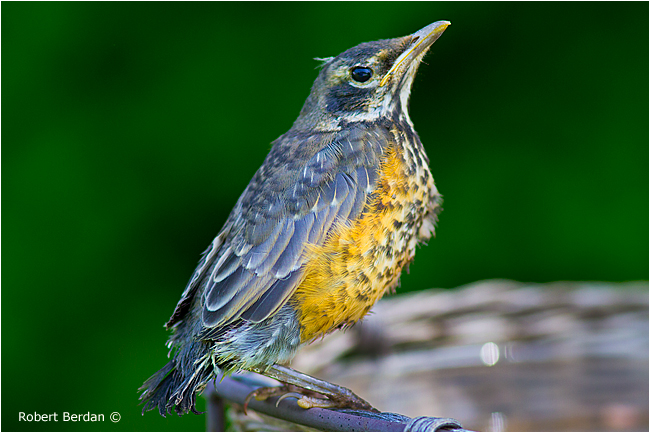
June 16 - first flight from the nest to the bird bath. This was the last robin to leave the nest.

June 16 one of the adult robins feeding a young robin at the bird bath. All of the robins have left the nest and seem tostaying closeby in the nearby trees while the parents continue to feed them worms. The entire development from egg to fledging took less then 2 weeks, possibly due to the warm weather and plentiful food.
Question: If I handle a baby bird, won't its parents pick up my scent and abandon it?
Answer: It's a myth that parent birds will abandon young that have been touched by humans—most birds have a poor sense of smell, and birds in general identify their young using the same cues we humans do—appearance and sound. It's perfectly safe to pick up a fallen nestling and put it back in the nest, or to carry a fledgling out of danger and place it in a tree or shrub (source Cornell Ornithology ).
Want to attract Robins? Cut your grass! One study found that robins spend less time foraging on a lawn as the grass grew longer. Mowing the grass also induced a short-term enhancement in the time the robins spent foraging, and they appeared to be more successful hunting for worms in short grass. I showed this trivia to my son who is responsible for cutting the grass at our home in hopes he would continue to cut the grass once a week.
Robin with a caterpillar, studies show robins prefer short grass - so keep your lawn cut. 300 mm F4 lens.
Robins visit my bird bath frequently.
Robins feed on dried berries, insect larvae, beetles, caterpillars and worms. Robins belong to the Thrush family and contain seven subspecies. The males chest is brighter, an orangey/rufous color, while the female has a pale orange chest. Males also tend to have a darker head while that of females tends to be a pale brownish grey. A male robin will have a white throat with a black streak down the middle. A female robin will have an almost pure white throat. The robins in my backyard seem to have multiple black streaks on their white throat. Below are some photos of robins I have photographed in the past.
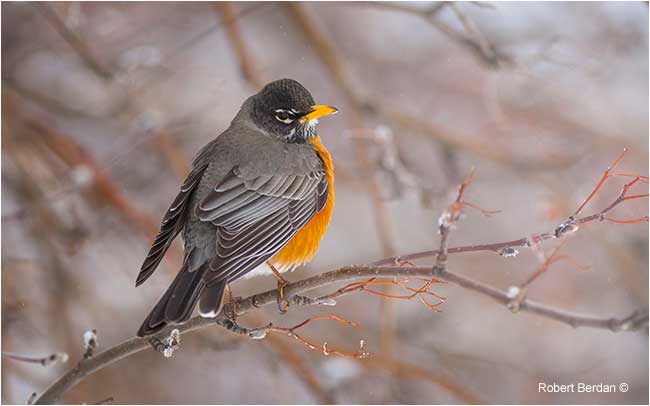
A fresh snowfall greeted this Robin photographed in Black Diamond, Alberta. 300 mm F2.8 lens

Robin at Ingelwood Bird Sanctuary on one of the many paths in the park.
300 mm F2.8 lens.

Robin in an apple tree, Black Diamond, AB 300 mm F2.8 lens. (DM - image converted to BW and colour returned to bird.)
Adult robins are preyed upon by cats, large snakes, and hawks. The Brown-headed Cowbird sometimes lays an egg in robins nests, but robins usually reject the cow bird eggs. At one time robins were once hunted for their meat, but are now protected in the US by the Migratory Bird Act. Robins are also known to be hosts for the West Nile virus spread by mosquitoes. Robins can sometimes cause damage to crops, but generally they are beneficial in that they aid in seed dispersal and help control insects including caterpillars, weevils and beetles.

Scientists estimate cats kill hundreds of millions of birds every year in North America and recommend you keep your cat indoors. Our cat, named "Itchy", a Ragdoll cat, was just as curious as I was when the robins were in the backyard. Our cat is strictly an indoor cat, but he exhibits an unusual behaviour when he sees or hears birds, he chomps his teeth. If you do let your cat outside, a collar with a bell will help warn a bird of the cat's approach. Also keep bird feeders and bird baths at least five feet from shrubbery that can conceal a stalking predator.
Backyard Robin
I minute HD video of robins feeding young at the nest. Filmed with a compact Pentax Optio Camera WG-2.
If you become interested in bird photography, the best way to start is to photograph common birds in your neighbourhood and backyard. Setting up a bird feeder and bird bath will help attract birds to your yard. Consider buying a bird guide and you can begin to identify and learn more about the many birds that come to visit. There are also bird recordings you can purchase (e.g. birdjam) and listen to in order to be able to identify birds by their song. Birding and bird photography can be addicting. RB
Photography Notes: Robins are found almost everywhere in North America and are relatively easy to find in most neighbourhoods from spring to early autumn. In most instances you will need a telephoto lens (e.g. 70-300 mm) lens to capture a closeup. To add a catch light to the birds eye I sometimes use a flash attached to my camera with the flash set at -1 EV. In bright sunlight you may have to set your lens f-stop to about f/11 when using a flash. Most of my pictures of robins were taken with a 300 mm F2.8 or F4 lens wide open. The pictures of the eggs and young were taken using a compact Pentax Optio WG-2 camera in macro mode. RB |
The robin was featured on the Canadian $2 note in 1986. The bill is no longer being printed. |

